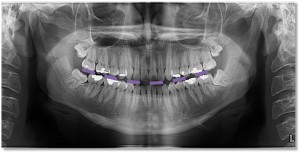This week I am showing an example of an ideal pantomograph along with 6 criteria that are used when determining the quality of a pantomograph. The next couple weeks will be showing examples of when those 6 criteria are not met and how to correct them.
1. Patient has anterior teeth in notches on bite block.
 This effects the size of the anterior teeth (yellow circle) on the image. If the anterior teeth appear close the size they are in the oral cavity, this criteria was met.
This effects the size of the anterior teeth (yellow circle) on the image. If the anterior teeth appear close the size they are in the oral cavity, this criteria was met.
2. Patient has midline (anterior and posterior of head) aligned with sagittal midline indicator light creating symmetry between the left and right side of the patient.
 This effects the size of the posterior teeth and ramus. If the molars on each side are the same size (white arrows), this criteria was met.
This effects the size of the posterior teeth and ramus. If the molars on each side are the same size (white arrows), this criteria was met.
3. Frankfort horizontal plane is positioned on the correct anatomical landmarks creating a slight concave occlusal plane.
 This effects the occlusal plane and whether the jaws are in the focal trough. If the occlusal plane has a slight concave appearance (purple dotted line), this criteria was met.
This effects the occlusal plane and whether the jaws are in the focal trough. If the occlusal plane has a slight concave appearance (purple dotted line), this criteria was met.
4. Patient standing or sitting tall to prevent overlap of the cervical vertebrae over the ramus of the mandible.
 This effects being able to view the posterior aspect of the ramus. If the cervical vertebrae are not superimposed over the lateral aspect of the ramus (green arrow), this criteria was met.
This effects being able to view the posterior aspect of the ramus. If the cervical vertebrae are not superimposed over the lateral aspect of the ramus (green arrow), this criteria was met.
5. Patient has tongue to roof of the mouth and lips around bite block or closed together gently.
 This effects the visibility of the roots of the maxillary teeth. If there is a uniform radiopacity over the maxillary roots (orange circle), this criteria was met.
This effects the visibility of the roots of the maxillary teeth. If there is a uniform radiopacity over the maxillary roots (orange circle), this criteria was met.
6. No visible metal present other than restorative materials.
 This effects several areas of the patient including the lateral aspect of the ramus and nasal cavity regions. If there is no visible metal present obscuring the image (blue circles), this criteria has been met.
This effects several areas of the patient including the lateral aspect of the ramus and nasal cavity regions. If there is no visible metal present obscuring the image (blue circles), this criteria has been met.
The ideal pantomograph without any animations.
 The next three weeks will have examples of what happens when these 6 criteria are not met (2 criteria per week). So get ready for the bad and ugly pantomographs. 🙂
The next three weeks will have examples of what happens when these 6 criteria are not met (2 criteria per week). So get ready for the bad and ugly pantomographs. 🙂
If you have any questions or comments, please let me know. Thanks and enjoy!
SPONSOR

I have a question- the appearance of the roots of the lower incisos in a pantograph often appear short- even in the example above. The lower canine roots – seem amost twice as long. Is there a reason for this? I hope I am not showing my ignorance.
The reason the mandibular incisor roots seem shorter is due to the lingual inclination (apex more lingual than crown) and the direction of the x rays. I’ll work on a post on how pantomographs are made with the inclination of the x rays. Thanks for the good question and I get this one quite frequently, so no worries about any ignorance. 🙂
great article 🙂 appreciate your work. Very informative